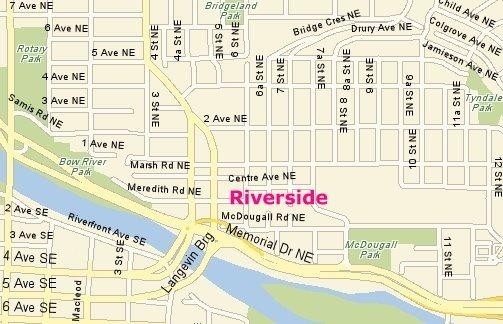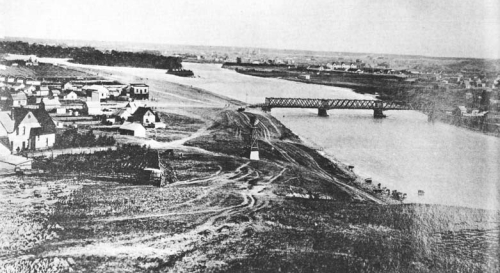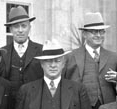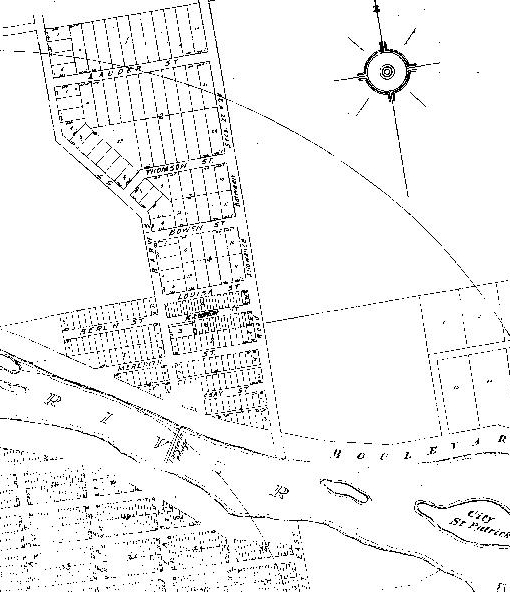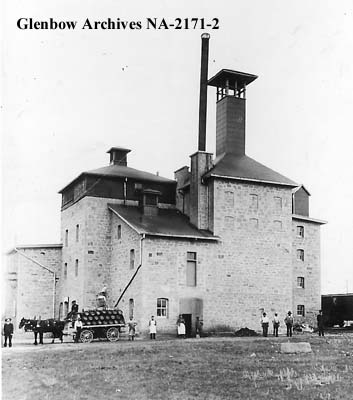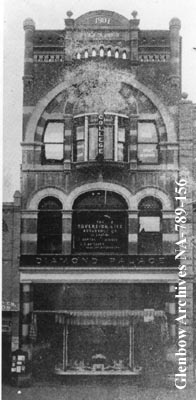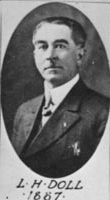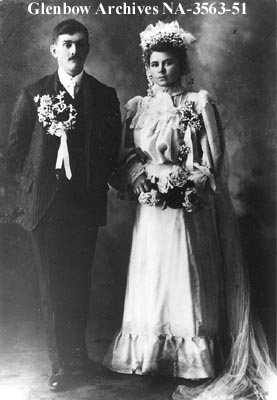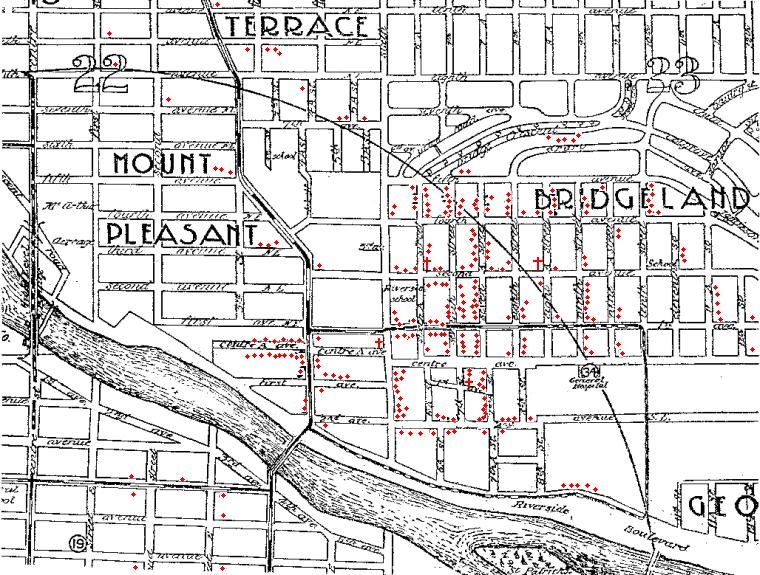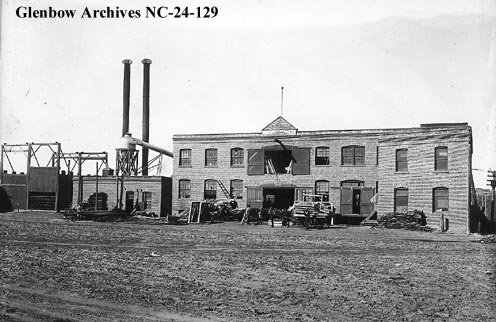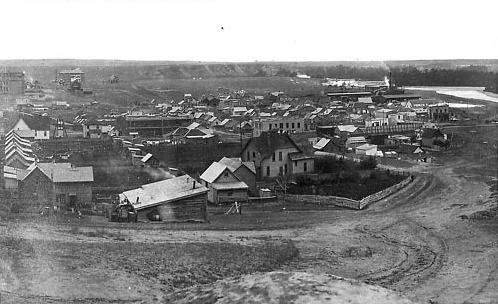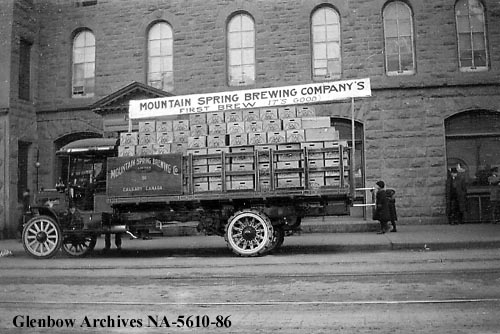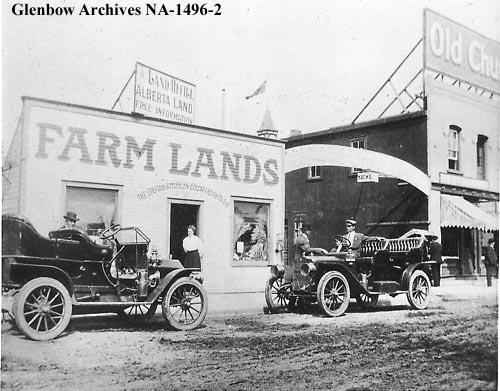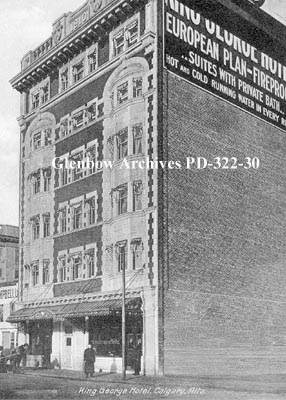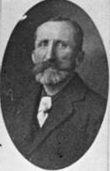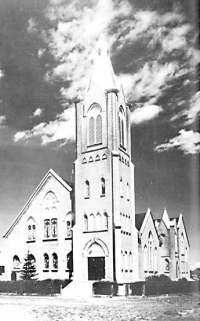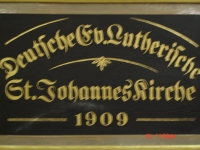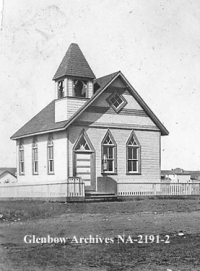
Settlement history of "the Germans" in Calgary between ca. 1900 and 1914The Canadian Census reported persons of German origin in the Calgary and Red Deer District for the first time in 1885; they numbered 53. But strong immigration from Central and Eastern Europe, from the U.S., from eastern Canada as well as some from Germany pushed up the numbers rapidly: In 1901, there resided 197 persons of German origin in the City of Calgary, and their number rose to 1,608 by 1911. Place of birth is another indicator of the "German presence." In 1901, the Canadian Census reported that
40 residents each of Calgary had been born in Germany and Russia, respectively; ten gave the U.S. as their place of birth, and five
Calgarians with German-sounding names were born in Austria. [Details]
The 1884 Henderson’s Gazetteer and Directory of Manitoba and the Northwest Territories listed only three German-sounding names for Calgary (Th. Schneider, a producer and agent, and two gunsmiths, Stephen Straube and V. Strauke). Two years later, Joseph Bannerman (tobacconist) and C. Neibergall (a brewery and saloon proprietor) were the only listings with a German-sounding name. Inferring a “German presence” from a listing in a business address and telephone directory is, at best, a hazardous undertaking. At that time, there was no guarantee that in fact all Calgarians were listed in the Directory, or were indeed listed with the correct spelling of their names; it is possible therefore that a few inhabitants of German origin may have been overlooked inadvertently. More importantly, many names can, of course, not be assigned uniquely to one language or another. “Neibergall” probably indicates German origin; the spelling variation may be due to a printing error or a transcription error, or the person may have informally or legally changed his name. “Korngiebel”, “Leistner”, “Mueller”, Grueningen” are very likely names indicating German origin as would “Koch”, “Querengesser” or “Rasch.” But then there is “Sugarman”; he was repeatedly referred to in the German-language newspapers as “running the finest German store in Edmonton”; presumably he had changed his name from “Zuckermann”, but it is impossible to be sure. Similarly, “Kline” may be a recent change from “Klein”, and “John Black” from “Hans Schwarz”. “Eden”, “Gross” and “Guttmann” may refer to German origin of some kind in the person’s background, but not necessarily so. The ethnic reference in last names such as “Walter”, “Martin”, “Wolf” or “Jordan” must remain indeterminate. Yet, keeping track of the number of German-sounding names in the community certainly offers clues to the number of residents of Calgary who were of German origin in the cities’ early days - especially if care is taken to use the same criteria for selection, and to err on the side of caution in selecting names for inclusion. "Germantown" between 1902 and 1906The first group of German-speaking settlers - almost all of them Volga Germans from Jagodnaya Polyana - arrived in Calgary in 1892. They were followed around the turn of the century by another large group of Germans from Russia, namely from Alexanderdorf in the Caucasus. Immigrants of German origin settled mostly in an area northeast of downtown Calgary; it would later be named Riverside and Bridgeland (while the Italians predominated in Bridgeland, a few "Germans" lived there as well). Even though an active community had existed since the late 1880s the area was not annexed by the city until 1910.
Most Germans came from Russia, but a considerable number moved north from the U.S., among them, for example, Charles Traunweiser, one of the first "German" business owners in Calgary. He was born in Ogdensburg, New York, the son of Ferdinand (born in Germany) and Maria Traunweiser. The family went to Iowa when Charles was still very young. After he completed his schooling, he was in the barber business until he came to Calgary in 1893. There he bought a barbershop which had been owned by his brother and ran it for eight years. Subsequently, he went into the tobacco business, purchased the old Commercial Hotel and started the Yale farm, a very large spread northeast of Calgary. However, his main interests still lay with his businesses in town. Among his other properties he owned the Hub cigar store and billiard hall in Calgary. In 1902, the district near Langevin Bridge with its concentration of German-speaking residents was referred to as “Germantown”. Indeed, some streets in Calgary carried German names, e.g., there was a Berlin Street (later 2nd Ave. NE) and Dresden Street (later 6th Street NE from McDougall to 5th Avenue).
According to Gronlund’s 1902 Directory the residents of "4th Street East to Riverside German Town" were Con Stucker, Henry Weitzell, John Keller and John Zimp. In the “settlement” itself, the household names listed were: Conrad Ruhl, Philip Rep, Conrad Goerlisz, Conrad Schneidmiller, Conrad Filger, Adam, Conrad and Heinrich Krumm, Adam Guss, Fred Lehr, Heinrich and John Gerlitz, Christian and Christian Jr. Poffenroth, Peter Goerlisz, Johann Schneidmiller, Charles Denkauf and Hans Schimpf, plus five households with non-German sounding names.
The Directory listed altogether 66 German-sounding names for the entire Calgary City and District. Twenty worked for the CPR, 18 for the Calgary Brewing Company and three for the Eau Claire Mills out of the conservatively counted total of 66 Calgarians of German origin. There were also many shoemakers, carpenters, barbers and labourers among Calgary’s German-speaking population at that time.
Most Calgarians of German origin appeared to have worked in the trades, but a few Germans ran their own businesses or were employed in a more elevated capacity, e.g., the above-mentioned Charles Traunweiser ran a barbershop and cigar store in the Clarence Block in 1902, L. H. Doll was a watchmaker and jeweller with a shop on Stephen Avenue West (see below), and L. J. Weisgerber was an accountant for Calgary Hardware.
Indeed, it did not take long for the Germans to branch out into more prestigious occupations: In 1906, John A. Schmidt owned the Royal Bakery at 512-8th Avenue East; Alfred D. Fidler ran a billiard and pool room and was the proprietor of the Athletic Cigar Store; John Koehler was a brick manufacturer at the Nose Creek Bridge; Rudy Joseph a building contractor, Edward Ferdinand had a tannery on 3rd Avenue; W.G. Ziegler was vice-president of the Calgary Saddlery Company; Hans Stoecke was the manager of the Pioneer Market; Henry Poffenroth owned a dairy and was a dairy farmer, prominent in the breeding of Holstein cattle in Pine Creek (today's De Winton near Okotoks). Paul Berg was the owner of the Calgary Hotel – a temperance hotel – on 7th Avenue East; a Dr. Mecklenburg had an optician’s practice on 8th Avenue; and Adam Poffenroth and John Kaesar [sic] owned the Riverside Meat Market on 6th Avenue East. The Café Halbe was located at 813 Centre Street. Bridgeland and Riverside between 1909 and 1914By 1909 Calgary’s suburban expansion had begun in earnest. The CPR offered certain subdivisions for sale to prospective home builders; the subdivision of Bridgeland was offered for sale to working men. Houses were erected on 25-foot frontages on what was probably the finest scenic land in the city. By this time, the number of Germans in Riverside increased substantially. The following map shows the location of residences, stores and churches of Calgarians with German-sounding names.
Germans comprised the largest single group of Europeans in Calgary in this period, numbering over 2,500 by 1911. A good number of the 900 immigrants from Austro-Hungary also lived in Riverside. Many Germans were among the 120 workers employed by the Riverside Lumber Company, which was owned by the Austrian-born Sereth Brothers. Others worked at the CPR, the breweries or in the manufacturing establishments across the river in the area aptly named "Breweryville."
The German business communityCalgary's German-language newspaper, Der Deutsch-Canadier, made reference to the following German stores, businesses and businessmen in Calgary between July 1909 and December 4, 1913: John Kaiser was the owner of the "Deutsches Gasthaus" in the Riverside Hotel in Calgary (514 Boulevard), which he also owned (April 22, 1909).
August Wolf was a typesetter at the Deutsch-Canadier. A few months later, he and Carl Horlach opened a German bakery on 4th Street NE in Riverside (July 9, 1909). Julius Kempe was the manager of "the only German hotel in Calgary", the Atlantic Hotel at 420-9th Avenue E (July 15, 1909). Paul Pouplier was the manager of the Golden West Brewery on the Blackfoot Trail (July 19, 1909). In 1910, Pouplier was President of the Club Harmonie, Deutscher Verein Calgary, 636-14 th Avenue East in Calgary (Deutsch-Canadischer Farmer, June 9, 1910). Emil Schuster was a type setter at the Deutsch-Canadier (July 29, 1909). C. Ehling became manager of the Alberta Barbershop at 436a-9th Avenue East in Calgary (September 16, 1909). In 1911, he was the owner of the Cochrane Hotel in Cochrane (December 4, 1911). Heinrich Hill announced that he would open a German butchershop in Calgary (September 28, 1909).
Christian Poffenroth was a candidate for City Council. He had been born in Russia and came to Calgary in 1892. Poffenroth was the president of the Deutsche Ansiedlungsgesellschaft von Alberta (German Colonization Company of Alberta) (Deutsch-Canadischer Farmer, May 12, 1910). He also owned the Albion Hotel in Calgary (December 9, 1909). In 1906 he had been reported to own the Riverside Hotel (Henderson's Calgary City Directory). Oscar Schumacher was an architect in Calgary (December 1, 1910). Paul Bergmann had a butcher's shop, the Farmer's Meat Market, at 4th Avenue and 3rd Street E. (August 3, 1911). Joseph Schuster was the president of the Hotel Cecil located at Third Street East and 4th Avenue in Calgary; Chr. Niemann was the manager (October 5, 1911); he was the manager of the Harmony Club at 223-6th Avenue East in Calgary in 1914 (Henderson's Calgary City Directory, 1914). Wilhelm Schultz was the manager of the Hotel Cecil Grill (November 4, 1911). A. Schlotthauer and G.S. McCollom were the owners of the Berlin Dye Works (Berliner Dampffärberei und Reinigungsanstalt) in Calgary (June 5, 1912). A.S. Frank from Munich was a landscape and portrait painter in Calgary. (June 1913, Immigration issue). J.A. Guttmann was the owner of the Deutscher Liquor Store at 326-8th Avenue in Calgary (June 1913, Immigration issue).
Konrad Knapp was the president and manager of the Mountain Spring Brewing Company in Calgary (June 1913, Immigration issue). Rudolf Krebs was the owner of the Alberta Café on 9th Avenue East in Calgary (June 1913, Immigration issue). Lorenz Zilliox owned the Togo Pool Room and Barbershop on 8th Avenue (June 1913, Immigration issue). The Hildermann Brothers owned a grocery and hardware store in Bridgeland at 903-1st Ave N.E. (September 4, 1913). The Riverside Fuel Co. at 402, 1st Avenue SE. in Riverside, Calgary was owned by Henry Miller and Henry Phoffenroth (December 4, 1913). In 1910, Henry Phoffenroth had apartments and business space for rent in the Henry Phoffenroth Block on 4th Street in Riverside (Deutsch-Canadischer Farmer, 1910).
John Steinbrecher of Calgary founded the German-American Colonization Co. in 1906 to bring Germans from the U.S. to Canada and settled many in Calgary and area (June 12, 1913). In 1910, the company sold over 100,000 acres farm land and a million dollars worth of city lots in 1910 (January 19, 1911). It located some 400 homesteads in the Stettler District and had subdivision developments in Calgary "for Germans moving out of Riverside and Bridgeland" (Balmoral, Avondale, Balfour, La Grange, Highland Park, and Pullman). In 1912, the executive officers were John and Arthur Steinbrecher. The Calgary Colonization Co. settled many people in the Calgary and Beiseker areas that were opened up originally by German speakers (June 12, 1913). Harry Honens was born in Milan, Illinois in 1868, his father a native of Germany and his mother born in Pennsylvania. After he completed his schooling, he was in the hardware business for many years. In 1903 he became interested in Western Canadian farm lands. He closed out his hardware stores, came to Alberta and was one of the first to handle Western Canadian farm lands on a large scale. Mr. Honens organized a company in High River which put on the market a tract of 60,000 acres that was sold in small portions to the settlers. After he had disposed of this land he came to Calgary and worked with the Calgary Colonization Company, handling their own lands and colonizing large tracts. He himself also owned large parcels of farm land in the Calgary District which he cultivated very successfully (MacRae, Archibald Oswald: History of the province of Alberta, Vol. II, p. 619). The Merchants and Manufacturer's Record of Calgary (1911) recorded Fred Wolff as the proprietor of the Apparel Service Comany (a dyeing and cleaning company). Charles Bell and J. Schiesel were reported to be the owners of the King George Hotel, which boasted of a grill and a rathskeller. Louis Henry Doll was born in Prince Albert, Ontario, in 1867, the son of Wilhelm Frederick von Doll, a German nobleman of Stuttgart, Germany, who - together with his brother and a business partner - emigrated to the U.S. Louis Doll was educated in the high schools of Port Perry, Ontario, and then engaged in the jewelry business with his stepfather in Port Perry. Subsequently he worked in the jewelry business in Toronto and Winnipeg. Taken by wanderlust he went to British Columbia, spent his fortunes and came to own a watch repair business. In 1899 Louis Doll came to Calgary and owned a jewelry store there (MacRae, Archibald Oswald: History of the province of Alberta, Vol. II, p. 900-902). Edward Knape's father was born in Germany. He came to Calgary in 1903 via the U.S. and operated a construction business there (MacRae, Archibald Oswald: History of the province of Alberta, Vol. I, pp. 864-865). Carl Wieting was brewmaster at a Calgary Brewery. His Bavarian lager beer is shipped out in all directions. (Der Nordwesten, July 29, 1897).
Alexander von Mielecki was born in Germany in 1854. He came to Calgary in 1886 and became a rancher in this area. Von Mielecki soon became active politically on behalf of German-speaking farmers, and as editor of the Deutsch-Canadischer Farmer from 1909 on he used this platform to rally them around the common cause. After becoming one of the directors of the United Farmers of Alberta in 1909 he called on them to join the UFA in large numbers to have the interests of Germans in Alberta represented. By 1910, the Germans made up 30% of the directors of the UFA (including von Mielecki and Emil Griesbach). In 1910, von Mielecki was elected director of the Grain Growers Company. Among other high-profile activities he was also present at discussions concerning a combination of an agricultural college with the University of Alberta. Von Mielecki was also active in Calgary's club life; under his presidency the Harmonie Club was reported to be active again in 1913. Club lifeThe Nordwesten reported as early as in November 1903 that "there are plans to establish a German club in Calgary. Its purpose will be to cultivate German language and culture among the German-born and to familiarize others with German language and culture," but it took until 1906 to do it. Also, the German clubs in Calgary enjoyed varied success between 1906 and 1914, for which the “disharmony and disunity” in the community was frequently blamed. The Harmonie German Club was founded in July 1906, and in just a few weeks it counted as many as 35 members and was reportedly off to a good start. Less than a year later, a new hall was opened at 638-14th Avenue East, and the first picnic was held. Christmas celebrations followed, and in March 1908, Goethe’s Faust was performed in the Club; a month later they showed “living pictures” in the hall. It was also announced that the Harmonie Club would have its own tent with German newspapers and books at the Dominion exhibition in May 1908. Other activities followed, such as masquerade balls. A German society - Die Deutsche Vereinigung von Brouse - was founded by Calgarians on May 28, 1910. Its motto was: "Einigkeit macht stark". The society had social objectives, among them health and death insurance. However, there is no further record of its activities. By 1911 the Harmony Club ran into some difficulties. It was closed in May because of a "sensationalist newspaper report", and the building was used as an exercise hall for an army regiment. In subsequent months, the Deutsch-Canadier, Calgary’s German-language newspaper, repeatedly suggested the club’s re-organization and re-opening, but the public response to these suggestions was said to be lukewarm. But by April 1912, the Deutscher Verein Frohsinn was organized with some 50 members; it used the dance hall at 832-2nd Avenue East for its gatherings and activities. In August another newly organized German club adopted the name Harmonie and held its gatherings at the hall of the Sons of Erin at 3rd Avenue und 3rd Street. However, after just a few months it was feared that both Frohsinn and Harmonie would have to be disbanded again. The newspaper suggested that Frohsinn could be revived if Calgary’s German population showed any interest. The Harmonie Club did in fact go under again in 1912. At the end of 1912, the Club Frohsinn, now called Concordia, was in trouble shortly after its reorganization because it violated liquor laws at a dance in November. In December, the club was said to have lost the support of the German-speaking community. Like a phoenix, the Harmonie Club rose from the ashes and opened again in May 1913 after a two-year closure, and the hope was expressed that the members of the Concordia Club would now join it. The Harmony club had a new location at 223-6th Avenue East, and according to the Deutsch-Canadier, the activities organized enjoyed much interest; a highlight was the Leipzig-Feier in October 1913. There was much charity work done by the club’s members, and Christmas celebrations were held, but in February 1914 the financial situation of the club was serious. The outbreak of the WWI brought the Club’s operations to a halt. It was re-founded after the War, and by March 31, 1920 it could boast again of some 300 members. ChurchesThere were seven German-language churches in Calgary around 1910 - four Lutheran churches, a German Baptist Church, a Moravian Church, and a Congregational Church. Lutheran Church (Missouri Synod) mission work in the Calgary area began as early as 1899 when Rev. Emil Eberhardt from Stony Plain made a trip to southern Alberta to visit Calgary and Pincher Creek. A congregation called Immanuel was established in Calgary and another, Trinity, in Pincher Creek, and they together became a parish (1900) to which Rev. E. Treu was called. The Calgary Pincher Creek Parish was divided in 1903. Immanuel Lutheran Church (4th Street and Centre Avenue), the oldest German-language church in Calgary, was founded in 1900 and in 1910 had 100 members, a German school and a German teacher. Immanuel’s parochial school was closed in 1913 (probably because of the general prejudice against the German language), the stated reason being a public health infraction. At that time, the church was in the process of building a new school and asked to continue the classes until the new building was ready but was not allowed to do so.
In 1912 disruptions had occurred in Immanuel Lutheran Church, and by 1913 the rift caused an ideological split in the congregation with one group of about 200 faithful leaving to set up St. Paul's Lutheran Church. A building was started, but soon dissension started among the seceders, and the church was never finished. After much acrimony, the original group organized to form Jehovah Lutheran Church (renamed St. Matthew in 1960). First they met in a private Halle supplied by a lay member of the congregation; subsequently services were held in the Methodist Church at 7A Street and 1st Avenue NE until they were formally organized in 1919. The congregation began work on their own building at 6A Street and Murdock Road in 1920.
Most of the immigrants to Riverside/Bridgeland were Russian-Germans, and understandably they wanted to set up churches similar in the principles of faith to the one which they had left behind. This led to some difficulties, especially with the leadership of the Missouri Synod which insisted on North American over European hymnnal and traditions. According to German pastors in Russia, the Lutheran Iowa Synod was said to be the one that taught the "undefiled and pure doctrine of the Lutheran Church." Although membership in the Ohio Synod was also considered briefly, St. John's (Iowa Synod) was founded in 1909. Rev. Karl Boetke became its first pastor, and the first service was held in a Baptist hall which was situated at that time on 1st Avenue NE. In the same year, a lot was purchased on 1st Avenue and 6A Street, and the new church was opened in in July 1910. After Rev. Boetke left, no pastor was sent from the Iowa Synod for a long time. For this reason, Rev. P.W.H. Loeschke from Zion Lutheran Church (Iowa Synod), which had a building just a few blocks away at 8A Street and 2nd Avenue, was asked to serve St. John temporarily. Then a pastor from the Ohio Synod came to St. John, Rev. George Stamm. He and his successor served the congregation and also helped in disbanding Zion Lutheran in 1918, when this became necessary, and invited its members to join St. John.
The Moravian Brethren's Church was founded in 1902 under the leadership of Reverend Clement Hoyler and had 41 families as members in 1910. This was the first Moravian Church in Alberta to be established in an urban area. The first pastor to serve this congregation was the Reverend Emil Suemper, a recent seminary graduate. In 1913, the congregation moved to a larger church building where it remained until 1945. The original building at 7th Street and 1st Avenue would be called St. Matthew’s Lutheran in 1960. In its edition of June 12, 1913, the Deutsch-Canadier reported that the cornerstone was laid for the church of the Deutsche Erlösergemeinde Nord-Calgary at Centre Street and 32 Avenue N.W. in Highland Park. The opening ceremony was scheduled to take place on September 14, 1913. However, no record has been found of the existence of this church at that time. A Redeemer Lutheran Church would only be founded in 1955. The first church established by German Baptists in the city of Calgary was known as the First German Baptist Church (655 Centre Street); it was founded in July 1912. The 1914 Henderson's City Directory listed a German Congregational Church at 2nd Avenue and 9th Street, likely the Ebenezer Congregational Church. NewspapersAll German-language newspapers in Alberta at the time (Alberta Herold, Der Deutsch-Canadier, Alberta Deutsche Zeitung, Der Deutsch-Canadische Farmer) tried to cover the entire province with more or less success; often they resorted to pieces by their correspondents ("Eingesandt"). Winnipeg's Nordwesten was present as well, but had much less of a profile than the local papers in Edmonton and Calgary.
In July 1909, the Deutsch-Canadier moved to Calgary from Edmonton, eventually to 1216-1st Street East. It said that it wanted to project a new image as a politically independent paper and no longer wished to represent views of Conservative party as a certain paper in Edmonton did. But despite many protestations to the contrary, the Deutsch-Canadier clearly favored the Liberal Party and endorsed its candidates in the provincial election of 1913. With the beginning of WWI, it became ever more difficult to attract readers and advertising, and in February 1914 the Der Deutsch-Canadier Ltd was liquidated because of financial difficulties and disagreements among its owners. Well-known businessman and political candidate Charles Pohl left the paper as president and manager. Despite new ownership and many calls to the readership to support the newspaper it eventually folded with a final issue on September 3, 1914. Calgary's Germans in local politicsPersons of German origin were not well-represented in Calgary's political affairs around the turn of the century. The only ones who ever appeared to have a reasonable chance of success were: Christian Poffenroth had been born in Russia and came to Calgary in 1892 and was the president of the Deutsche Ansiedlungsgesellschaft von Alberta (German Colonization Company of Alberta). He was also the owner of the Prince of Wales Hotel in Wetaskiwin. In December 1909, Poffenroth ran - unsuccessfully - to represent Calgary's German-speaking population in Riverside in the Calgary municipal election. Carl Pohl was a well-known businessman in Edmonton and Calgary. In 1909 he became editor of the Alberta Herold in Edmonton, but then moved to Calgary where he became a hotel owner and president and manager of the Deutsch-Canadier. Although was endorsed by the Deutsch-Canadier and the Alberta Deutsche Zeitung in the Calgary City Council elections in 1912 he lost to his opponent. Click here for an overview of "the Germans'" political involvement elsewhere in Alberta. Return to the Brief overview of the immigration history of
Alberta's German-speaking communities: Part 1 |

